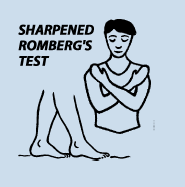Self-Test for the BendsContents of this Issue: Diving From Costa Rica's Mainland TRAVEL TIP— FIJI & NEW ZEALAND Editorial Office: Ben Davison Publisher and Editor Undercurrent 3020 Bridgeway, Suite 102 Sausalito, CA 94965 from the October, 1999 issue of Undercurrent
Well, there is a test that might tell you if you have had an inner ear or spinal hit. It’s called “Sharpened Rombergs Test.” But before you try it on a dive trip, you must do it four times before you leave home to get a baseline for yourself. Here’s how.
The test measures any change in balance that might indicate an inner ear or spinal cord hit. Dr. Hugh Greer, a neurologist, told us, “Docs do not use this test because it takes too much time. But it is a good indication of balance and whether there have been any changes.” Dr. Kelly Hill, Jr. Medical Director of Hyperbaric Medicine at Our Lady of the Lake Medical Center in Baton Rouge, LA, is less sure the test is helpful. “It may indicate DCI problems when there really are none. But, even worse, the test may indicate no problem, but the hit may be somewhere other than the inner ear or spine, and it will go untreated.” The test must be conducted from a stable platform. Don’t try it on the deck of a moving boat or when water conditions cause the vessel to move even slightly. Also, some people, particularly older divers, cannot stand for 60 seconds, even if they haven’t been diving for years. But if you’re off to sea, the test is one more tool in your kit |

I want to get all the stories! Tell me how I can become an Undercurrent Online Member and get online access to all the articles of Undercurrent as well as thousands of first hand reports on dive operations world-wide
| Home | Online Members Area | My Account |
Login
|
Join
|
| Travel Index |
Dive Resort & Liveaboard Reviews
|
Featured Reports
|
Recent
Issues
|
Back Issues
|
|
Dive Gear
Index
|
Health/Safety Index
|
Environment & Misc.
Index
|
Seasonal Planner
|
Blogs
|
Free Articles
|
Book Picks
|
News
|
|
Special Offers
|
RSS
|
FAQ
|
About Us
|
Contact Us
|
Links
|
3020 Bridgeway, Ste 102, Sausalito, Ca 94965
All rights reserved.

 Have you ever gotten out of the water not
feeling as good as you thought you should feel?
Maybe you pushed the computer a little and
worried that you had a bends hit.
Have you ever gotten out of the water not
feeling as good as you thought you should feel?
Maybe you pushed the computer a little and
worried that you had a bends hit.
